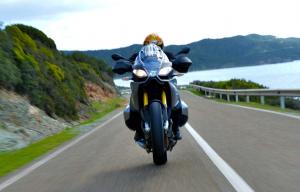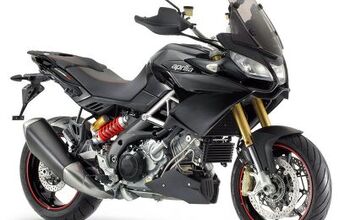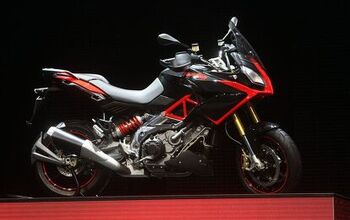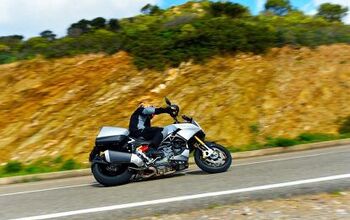2013 Aprilia Caponord 1200 Review - Motorcycle.com
Aprilia’s contribution to the do-it-all touring segment is finally here. The new Caponord 1200 revives an old name and is endowed with a slew of electronic gadgets and riding aids.
Forget all you know about the ETV1000 Caponord. The only thing that remains the same is the fact that the engine is still a V-Twin, but this time it uses the big 1197cc V90 from the Dorsoduro maxi-motard.
The Caponord’s two-part seat is well padded and ergonomically shaped for both rider and pillion. The seat is also comfortable during hard braking with a nice extension up the rear part of the 6.34 gal fuel tank. The 33.1-inch seat height is neither too tall nor too low, and the reach to the footpegs is relaxed. The handlebars are within easy reach whilst maintaining a straight back, so there is nothing overly sporty in the riding position.
The chassis is built to be both sporty and comfortable with more than a slight emphasis on sporty. In essence it’s the same chassis as the corner-munching Dorsoduro, but the rear wheel is mounted further back on the swingarm, creating a longer wheelbase. A steel trellis and aluminium plates connects front with rear. Aprilia has chosen pure sportbike tires (Dunlop SportMax Qualifiers) in a 120/70-17 front and 180/55-17 rear. Should one wish to change to something less sporty and longer lasting, the Caponord's traction control system will need to be re-calibrated via an 8-second self-calibrating sequence after getting new shoes, which, in our experience with the RSV4, is easier said than done.
Our ride started out with a few relaxing and straight “A” roads which gave an opportunity to test the adjustable windscreen. It’s comfortable enough in its lower position, but in foul weather the upper position will be required. I preferred to keep it in its lowest position most of the time because it caused buffeting at helmet level when set high. The windscreen is adjusted with two knobs and it simply is the most low tech solution on the Caponord. The windshield is not the best part of the bike.
ACC (Aprilia Cruise Control) is included in the Travel Pack version, which we tested, and it’s amazing to have such a feature on something as fast as the Caponord 1200. It only works between third and sixth gear.
The Caponord started showing its true character when the corners started to arrive. Straight away on unknown roads I felt fast, and the new ADD (Aprilia Dynamic Damping) really takes care of the chassis. The ADD system works by reading information from a host of sensors and accelerometers including a swingarm sensor, a fork pressure sensor measuring the speed of which the air in the fork is compressed and decompressed, and some (Ducati) Skyhook methodology to measure low frequencies.
The difference between the simpler Skyhook system on Ducati’s Multistrada and Aprilia’s ADD is the fact that ADD uses mathematical algorithms on actual data filtering the low frequencies and the high frequencies. Aprilia lets you choose from four different modes, including a rider with pillion setting and a fifth completely automatic setting which takes care of any change in road scenario. In the auto mode the rear shock is fully dynamic and not semi-active.
Auto mode is actually all you will ever need on this motorcycle as the system adjusts load and suspension by detecting weight, so the extra weight of a passenger or luggage is catered to automatically. The other mode selections are, according to Aprilia’s own engineers, purely a gimmick to make riders think they’re contributing. Sachs supplies the suspension mechanical parts while Aprilia have applied their own technology and algorithms.
You don’t even notice the suspension action whilst cruising at a relaxed pace, and the comfort is superb. Going fast through the corners, the true brilliance of the ADD system really starts showing. You can go from soft to hard suspension in just twisting the R-b-W throttle, and I couldn’t fail the suspension and chassis in any way.
I tested with traction control set to levels 2, 1 and off using both the Touring and Sport riding maps. Touring map and TC level 1 gives an experienced rider enough thrills to stay happy in mixed riding, but for pure mountain carving at high speed, TC must be at level 1 and Sport mode chosen for a more direct throttle response. TC level 1 also allows for a higher wheelie than usual. If you don’t want any wheel spin and prefer both wheels on the tarmac at all times, then you’ll want Touring mode with TC at level 2.
I really tried to upset the chassis as much as I could by exiting slow corners in as low a gear as possible for maximum power. With TC level 1 it’s possible to experience some wheel spin, but there’s still a bit of a safety net. ATC, ABS and ADD together can be a life saver, and Aprilia has given enough adjustability for most people to have as much fun as they like while maintaining some safety. The brakes are double 320mm discs with radial Brembo M430 callipers fitted with the same two-channel ABS as the Dorsoduro. The ADD system and the ABS brakes work together flawlessly.
The Caponord 1200s we tested were fitted with the Travel Pack, which includes 7.7-gallon panniers, a centerstand and extra electronics (ADD cabling alone weighs 2.2 lbs). Its dry weight is claimed to be 503 lbs, which is 31 lbs more than the standard model.
Compared to the Dorsoduro 1200, the 1197cc V90 is detuned for better and more torque at lower rpm. The 6-speed transmission is also fitted with a lower gear ratio so the Caponord 1200 is superbly responsive and ultra smooth to get going in first gear. New 52mm throttle bodies are fitted (57mm on Dorsoduro 1200) to improve fuel economy. There’s a new exhaust valve and a new muffler which is adjustable in height for even better ground clearance and aesthetics if panniers are removed.
The heavily reworked V-Twin is said to produce 125 horsepower at 8250 rpm. Its 84.8 ft-lbs. of torque arrives at 6800 rpm, 400 revs lower than Dorsoduro 1200. Its power surge is strongest from 7000 rpm, but there’s plenty of oomph also at lower rpm. Aprilia have created a version of its 1200cc V-Twin that is more than happy to move you forwards with considerable authority also from low revs, but it’s still a lot of fun to use the top end for the ultimate ride in the mountains. The footpegs touch down in the corners, and perhaps also the centerstand if it’s a bumpy corner, but with absolutely no drama.
One practical detail missing is heated grips. The button is there but doesn’t work unless you pay extra for the option, even with the Travel Pack. The Caponord includes hand guards, but in cold or wet weather heated grips, are always a good idea anyway.
I also got to test Aprilia’s latest iPhone app which will be available from May 2013. This gives you access to an unbelievable amount of real time data from the engine such as torque, power, revs (which you have on the original dash anyway) and percentage of power in use at all times. The application also features a highly sophisticated engine saving rev alerter and the whole dash goes red if you’re using higher revs than the engine likes while warming up. Not only has this feature got the potential to increase engine longevity but also optimise fuel consumption.
Riding with this application it’s the easiest thing in the world to become completely OCD in regards to lowering fuel consumption and taking care of the engine. You can’t use this application when going fast, at least not where it’s mounted at the moment, because you have to take your eyes off the road for a second to read the data. It’s completely fascinating to follow the torque figures as you can see exactly how much you are using, and I was genuinely surprised over how little is needed to cruise along at 60 mph in sixth gear and how much is needed to increase speed again.
It’s difficult not to recommend this application as a must for any Caponord 1200 owner. The application also registers on the GPS where you last parked the bike should you be a bit senile. The system is ready for satellite alarm and there will be future multimedia capabilities. Finally the application also knows exactly how far you are from the North Cape at all times. Nice gimmick Aprilia! The app will also be available for Android phones.
Depending on the equipment level, the Caponord 1200 is priced competitively in Italy where it will cost about €3000 less than Ducati’s Multistrada 1200.
Conclusion
The 2013 Aprilia Caponord 1200 is well and truly a technologically tour de force. No adventure-tourer should handle this well, and you simply can’t underestimate how important the new ADD system is in making this whole package come together. It all works and works really well. If you didn’t already get it, the Caponord 1200 is not a GS killer it’s a Multistrada killer, and my new favorite Adventure Superbike is called the Caponord.
| Highs: | Lows: | |
| ADD suspension and handling Great job in tuning the 1200 V-Twin for touring while remaining a superbly sporty package Comfortable riding position that doesn’t take much away from the handling | Simple windshield that doesn’t do enough in its highest position Centerstand can be laborious to apply in certain situations |
Related Reading
2013 Aprilia Caponord 1200 Review First Impressions
2013 Aprilia Caponord 1200 Revealed
EICMA 2012: 2013 Aprilia Caponord 1200 Officially Introduced in Milan
2013 Aprilia Caponord 1200 to Get APRC and Electronically Controlled Suspension
2013 Ducati Multistrada 1200 S Touring Review
2013 BMW R1200GS Review - Video
More by Tor Sagen





































Comments
Join the conversation